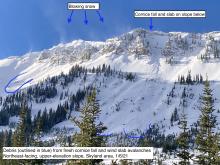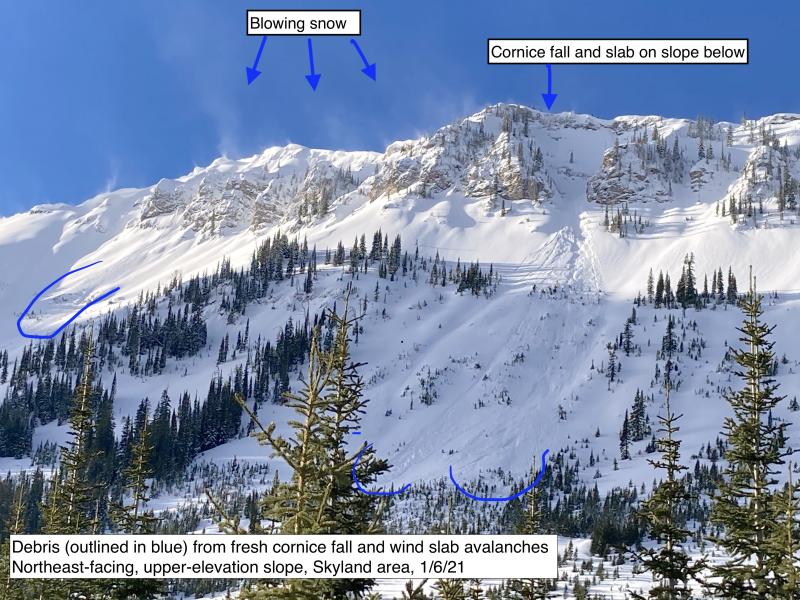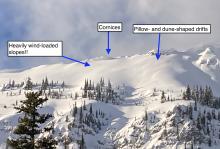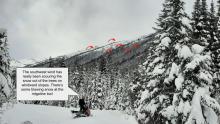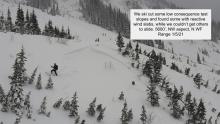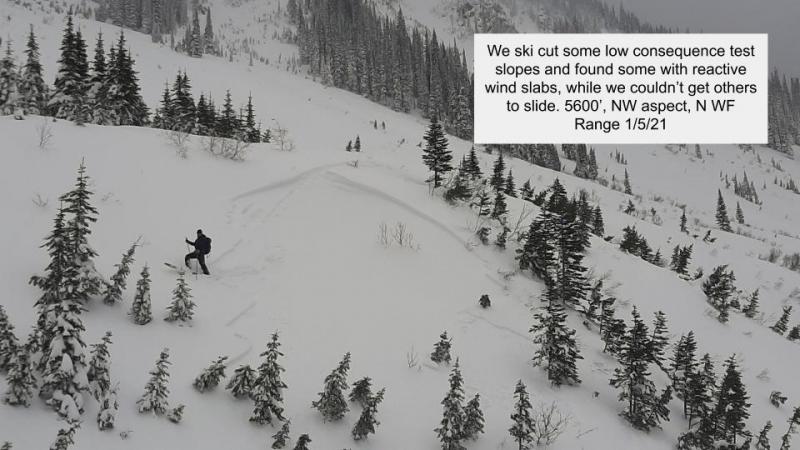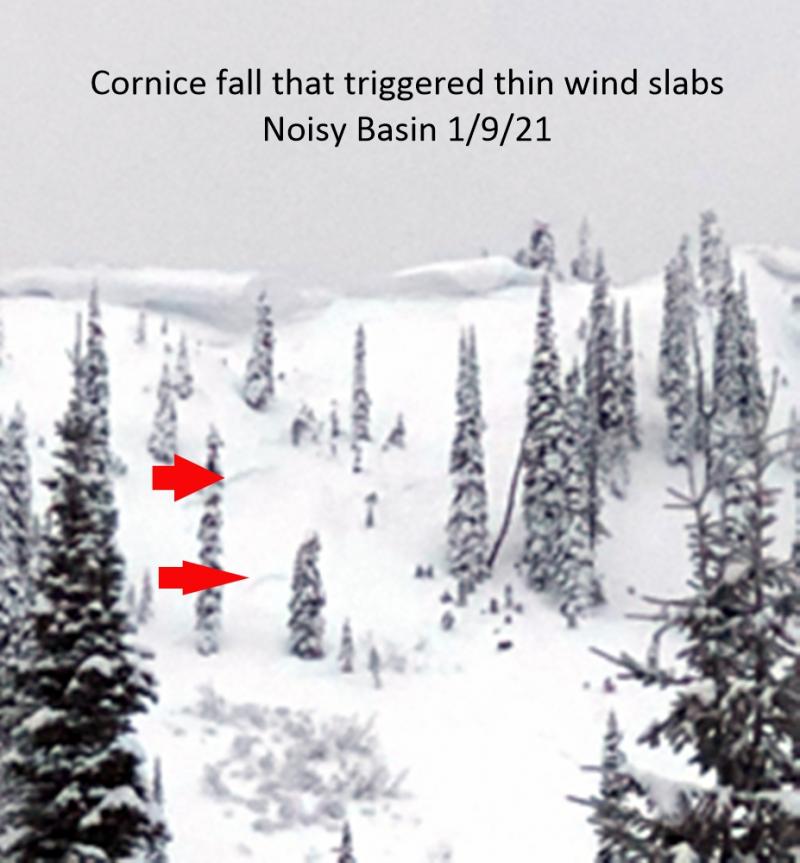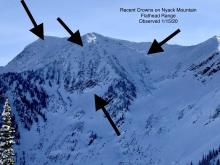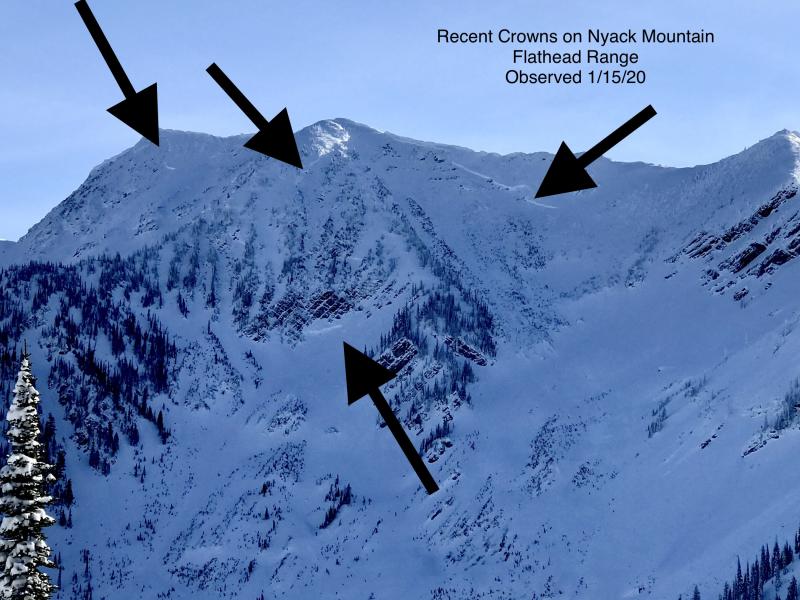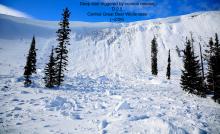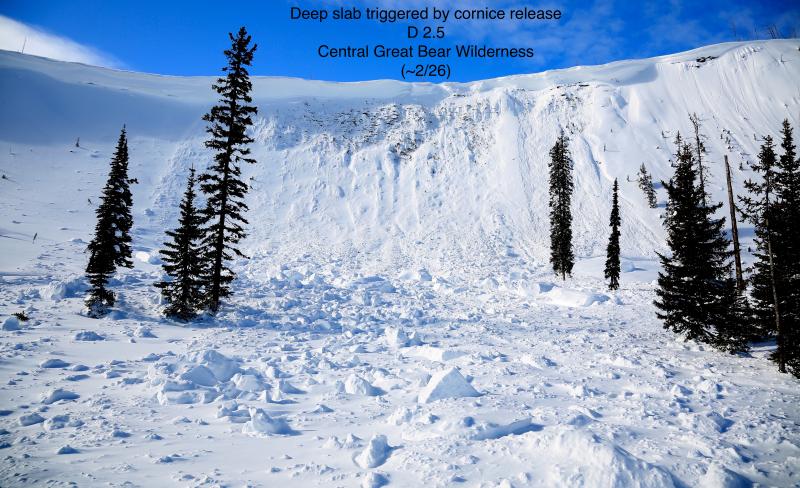| Wednesday | Wednesday Night | Thursday | |
|---|---|---|---|
| Cloud Cover: | Decreasing Clouds | Partly Cloudy | Mostly Cloudy |
| Temperatures: | 23 to 30 deg. F. | 11 to 15 deg. F. | 32 to 40 deg. F. |
| Wind Direction: | West | Southwest | South |
| Wind Speed: | 40G61 | 16G39 | 14G26 |
| Snowfall: | 3" to 5" in. | 0" in. | 0" in. |
| Snow Line: | 2500' | 1000' | 3000' |
Flathead Range and Glacier National Park
How to read the forecast
Strong winds and new snow are increasing the danger. Dense, textured snow that cracks around you means sensitive wind slabs. You can trigger slabs more than a foot thick below corniced ridges and on the sidewalls of chutes. Slabs may develop further downslope than usual, and even in normally sheltered areas. Watch for snow blowing to identify the most hazardous slopes. Avoid spending time below large cornices. If we get more snow than expected, the danger could rise to Considerable.

2. Moderate
?
Above 6500 ft.
2. Moderate
?
5000-6500 ft.
2. Moderate
?
3500-5000 ft.
- 1. Low
- 2. Moderate
- 3. Considerable
- 4. High
- 5. Extreme
-
Type ?
-
Aspect/Elevation ?

-
Likelihood ?CertainVery LikelyLikelyPossible
 Unlikely
Unlikely -
Size ?HistoricVery LargeLargeSmall

Strong winds will drift new snow into sensitive slabs in leeward terrain. At higher elevations, and in isolated areas down low, slabs may grow to a foot thick or more. Expect sensitive wind slabs on the down-wind side of ridges, rollovers, and trees. The sidewalls of chutes and gullies are also suspect. You can spot the more dangerous slopes from afar by watching snow blow onto them. Cornices will point to wind-loaded terrain below. Slabs may develop further down slope than usual, and in normally sheltered areas. Wind blown snow will be dense, rippled, and can crack under you.
-
Type ?
-
Aspect/Elevation ?
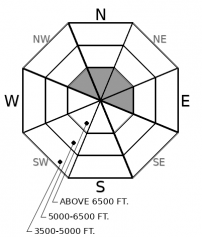
-
Likelihood ?CertainVery LikelyLikelyPossible
 Unlikely
Unlikely -
Size ?HistoricVery LargeLargeSmall

Cornice fall triggered a large avalanche that broke near the ground deep in the Great Bear Wilderness this past week, with a similar slide on Mt. Penrose the week before. Both slides occurred on northeast facing slopes. These slides are a good reminders of the lingering danger of large avalanches breaking on weak snow near the ground in high alpine bowls and on steep, snowy faces in the Flathead Range and Glacier National Park. Cornice fall is the most likely trigger for these unsurvivable avalanches. Even though deep slab avalanches are unlikely today, it’s good policy to limit your time under steep northerly and easterly start zones.
It gives me no joy to say that the safest riding today with be where the snow is crusty. New snow will come and go quickly this morning, falling and drifting onto sun crusts, melt-freeze crusts, rime crusts, wind board...
The Flathead Range, and east to Marias Pass look favored for up to 5 inches. The Swan Range may see a little less. An inch or two looks possible for the Whitefish Range. A quick refresh would be welcome, except that the winds of the past few days will only be stronger today. With winds as strong as they are, I expect slabs to form in unusual places: openings in trees and at lower elevations than is normal. If snowfall in the Flathead Range exceeds expectations, wind slabs will become larger, more widespread, and more likely.
Cornices will continue to grow over many ridgelines. Cornices are dangerous in and of themselves. Give these giant prows, and the slopes below them, a wide berth.
In isolated areas, persistent weak layers of surface hoar and near-surface facets have been found under the storm snow from 2/23. They seem to be dormant in most places with no propagation in tests and no recent avalanches on adjacent slopes.
Conditions could change significantly with above average temperatures under a high pressure ridge on Thursday and Friday.
Strong westerly winds are expected again today. Numerous snow showers diminish by this afternoon with increasing sunshine. A ridge will bring warmer than normal temperatures Thursday and Friday. Another weather system is on tap for the weekend.
This forecast applies only to backcountry areas outside established ski area boundaries. The forecast describes general avalanche conditions and local variations always occur. This forecast expires at midnight on the posted day unless otherwise noted. The information in this forecast is provided by the USDA Forest Service who is solely responsible for its content.



